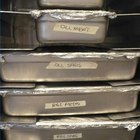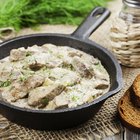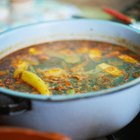Starkovphoto/iStock/GettyImages
Tips for Keeping Your Buffet Menu Cool and Safe
Keeping buffet food cold isn't just a matter of taste, it's also an important safety practice. Cold buffet food that isn't kept cool enough can grow harmful pathogens, creating the risk of food poisoning sickening your guests. It's especially important to keep proteins cold, so pay special attention to meats, beans and dairy products. But even seemingly safe foods such as rice and cooked vegetables can grow dangerous bacteria if you keep them for too long in the unsafe temperature range, which is between 40 degrees and 140 degrees Fahrenheit.
Using Ice in a Buffet
The ice you use to keep your buffet food cool shouldn't be in direct contact with the food. Instead, arrange ice in a separate bowl or pan and then place the container or dish with your buffet items into the bowl holding the ice. You can even purchase combination containers made specifically for this purpose.
If you're serving finger food on a platter, use a shallow pan as wide as the platter, and fill the pan with ice. Use crushed ice if possible, so you can distribute it well; even if you're using ice cubes, make sure they haven't frozen together into chunks that will make your food bowls or platters sit awkwardly. If you're placing a bowl with food inside a bowl of ice, make sure the ice is filled up to the level of the food. Use metal or Pyrex bowls for your food, because these materials will hold and transfer the cold from the ice most effectively. Check the ice levels often, especially on hot days, and replenish the ice as needed.
Other Strategies for Keeping Buffet Food Cold
Instead of heaping your buffet bowls or platters with salads and finger food that you'll need to keep cold, hold most of your food in a refrigerator or ice chest, and put out a little at a time. It's easier to manage the temperature of a small bowl of food than a large one, even though it takes a bit of extra work to replenish more often. If you're refilling platters, move the items that have been sitting out longest to the spots where guests will reach for them first, such as the top of a stack or the section of the platter closest to where guests come through the line and serve themselves.
Very Hot Days
The hotter the day, the more difficult it will be to keep your buffet food cold. Pay extra attention to ice and temperatures during the height of summer, and provide shade for the food too, if possible.
Related Articles
How to Keep Deli Meats & Fruit Cold at ...

Number of Times Food Can Be Reheated

How Long Is Leftover Spaghetti Good to ...

How Long Can I Keep Food Safe in a ...

Catering Tips for Delivering Food
Can You Cook Chicken Wings the Day ...

How Long Can Chinese Food Sit Out ...

How to Prevent an Ice Sculpture From ...

Can You Cook Something Frozen in the ...

How to Keep a Beer Keg Cold

Proper Ways to Cool Food After Cooking

Easy Wedding Potluck Meals

The Difference Between a Chafing Dish & ...

How to Keep Shrimp Cocktail Cold on a ...

How Long Can Cooked Salmon Last ...
How Long Can Leftovers Be Refrigerated?
How to Thaw, Cook & Refreeze Vegetables

Cold Buffet Ideas for Weddings

How to Keep Ham Slices Warm for ...

Containers That Keep Food Hot
References
Resources
Tips
- Keep cold foods that will be eaten raw, such as fresh fruits and vegetables away from meats, poultry and seafood to avoid cross contamination.
- Purchase special decorative serving platters that inlude containers meant to hold ice, allowing you to safely serve cold foods with a nicer presentation.
- Serve cold foods such as fruit and cold salads directly over ice, if you prefer.
Warnings
- Throw out any food that you are unsure of its temperature or how long it has been sitting at room temperature. It is not worth the risk of someone getting sick to leave it out.
- Do not allow cold food to sit out at room temperature for more than an hour if the weather temperature is over 90 F, unless it is over ice and you are monitoring the temperature.
Writer Bio
Devra Gartenstein is a self-taught professional cook who has authored two cookbooks: "The Accidental Vegan", and "Local Bounty: Seasonal Vegan Recipes". She founded Patty Pan Cooperative, Seattle's oldest farmers market concession, and teaches regular cooking classes.